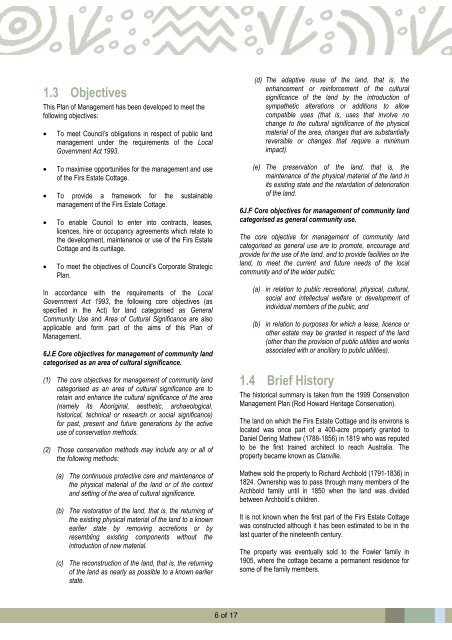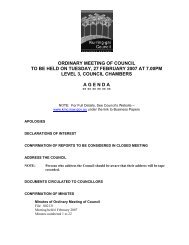The Firs Estate Cottage - Draft Plan of Management - Ku-ring-gai ...
The Firs Estate Cottage - Draft Plan of Management - Ku-ring-gai ...
The Firs Estate Cottage - Draft Plan of Management - Ku-ring-gai ...
You also want an ePaper? Increase the reach of your titles
YUMPU automatically turns print PDFs into web optimized ePapers that Google loves.
1.3 Objectives<br />
This <strong>Plan</strong> <strong>of</strong> <strong>Management</strong> has been developed to meet the<br />
following objectives:<br />
• To meet Council’s obligations in respect <strong>of</strong> public land<br />
management under the requirements <strong>of</strong> the Local<br />
Government Act 1993.<br />
• To maximise opportunities for the management and use<br />
<strong>of</strong> the <strong>Firs</strong> <strong>Estate</strong> <strong>Cottage</strong>.<br />
• To provide a framework for the sustainable<br />
management <strong>of</strong> the <strong>Firs</strong> <strong>Estate</strong> <strong>Cottage</strong>.<br />
• To enable Council to enter into contracts, leases,<br />
licences, hire or occupancy agreements which relate to<br />
the development, maintenance or use <strong>of</strong> the <strong>Firs</strong> <strong>Estate</strong><br />
<strong>Cottage</strong> and its curtilage.<br />
• To meet the objectives <strong>of</strong> Council’s Corporate Strategic<br />
<strong>Plan</strong>.<br />
In accordance with the requirements <strong>of</strong> the Local<br />
Government Act 1993, the following core objectives (as<br />
specified in the Act) for land categorised as General<br />
Community Use and Area <strong>of</strong> Cultural Significance are also<br />
applicable and form part <strong>of</strong> the aims <strong>of</strong> this <strong>Plan</strong> <strong>of</strong><br />
<strong>Management</strong>.<br />
6J.E Core objectives for management <strong>of</strong> community land<br />
categorised as an area <strong>of</strong> cultural significance.<br />
(1) <strong>The</strong> core objectives for management <strong>of</strong> community land<br />
categorised as an area <strong>of</strong> cultural significance are to<br />
retain and enhance the cultural significance <strong>of</strong> the area<br />
(namely its Aboriginal, aesthetic, archaeological,<br />
historical, technical or research or social significance)<br />
for past, present and future generations by the active<br />
use <strong>of</strong> conservation methods.<br />
(2) Those conservation methods may include any or all <strong>of</strong><br />
the following methods:<br />
(a) <strong>The</strong> continuous protective care and maintenance <strong>of</strong><br />
the physical material <strong>of</strong> the land or <strong>of</strong> the context<br />
and setting <strong>of</strong> the area <strong>of</strong> cultural significance.<br />
(b) <strong>The</strong> restoration <strong>of</strong> the land, that is, the returning <strong>of</strong><br />
the existing physical material <strong>of</strong> the land to a known<br />
earlier state by removing accretions or by<br />
resembling existing components without the<br />
introduction <strong>of</strong> new material.<br />
(c) <strong>The</strong> reconstruction <strong>of</strong> the land, that is, the returning<br />
<strong>of</strong> the land as nearly as possible to a known earlier<br />
state.<br />
(d) <strong>The</strong> adaptive reuse <strong>of</strong> the land, that is, the<br />
enhancement or reinforcement <strong>of</strong> the cultural<br />
significance <strong>of</strong> the land by the introduction <strong>of</strong><br />
sympathetic alterations or additions to allow<br />
compatible uses (that is, uses that involve no<br />
change to the cultural significance <strong>of</strong> the physical<br />
material <strong>of</strong> the area, changes that are substantially<br />
reversible or changes that require a minimum<br />
impact).<br />
(e) <strong>The</strong> preservation <strong>of</strong> the land, that is, the<br />
maintenance <strong>of</strong> the physical material <strong>of</strong> the land in<br />
its existing state and the retardation <strong>of</strong> deterioration<br />
<strong>of</strong> the land.<br />
6J.F Core objectives for management <strong>of</strong> community land<br />
categorised as general community use.<br />
<strong>The</strong> core objective for management <strong>of</strong> community land<br />
categorised as general use are to promote, encourage and<br />
provide for the use <strong>of</strong> the land, and to provide facilities on the<br />
land, to meet the current and future needs <strong>of</strong> the local<br />
community and <strong>of</strong> the wider public:<br />
(a) in relation to public recreational, physical, cultural,<br />
social and intellectual welfare or development <strong>of</strong><br />
individual members <strong>of</strong> the public, and<br />
(b) in relation to purposes for which a lease, licence or<br />
other estate may be granted in respect <strong>of</strong> the land<br />
(other than the provision <strong>of</strong> public utilities and works<br />
associated with or ancillary to public utilities).<br />
1.4 Brief History<br />
<strong>The</strong> historical summary is taken from the 1999 Conservation<br />
<strong>Management</strong> <strong>Plan</strong> (Rod Howard Heritage Conservation).<br />
<strong>The</strong> land on which the <strong>Firs</strong> <strong>Estate</strong> <strong>Cottage</strong> and its environs is<br />
located was once part <strong>of</strong> a 400-acre property granted to<br />
Daniel De<strong>ring</strong> Mathew (1788-1856) in 1819 who was reputed<br />
to be the first trained architect to reach Australia. <strong>The</strong><br />
property became known as Clanville.<br />
Mathew sold the property to Richard Archbold (1791-1836) in<br />
1824. Ownership was to pass through many members <strong>of</strong> the<br />
Archbold family until in 1850 when the land was divided<br />
between Archbold’s children.<br />
It is not known when the first part <strong>of</strong> the <strong>Firs</strong> <strong>Estate</strong> <strong>Cottage</strong><br />
was constructed although it has been estimated to be in the<br />
last quarter <strong>of</strong> the nineteenth century.<br />
<strong>The</strong> property was eventually sold to the Fowler family in<br />
1905, where the cottage became a permanent residence for<br />
some <strong>of</strong> the family members.<br />
6 <strong>of</strong> 17
















